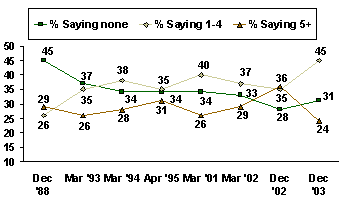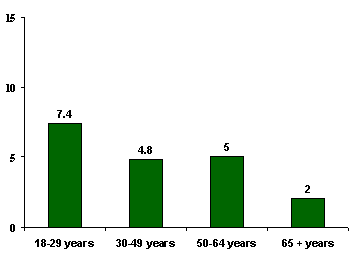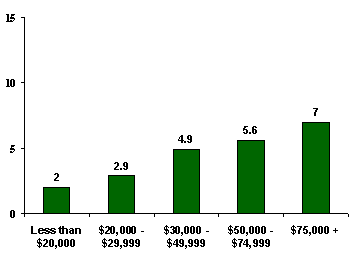GALLUP NEWS SERVICE
PRINCETON, NJ -- This weekend’s 76th annual Academy Awards, and the release of Mel Gibson’s movie, "The Passion of the Christ," this week have moviemakers making headlines. Based on Gallup’s 2003 survey of movie attendance, studio executives and theater owners must be hoping the buzz lasts and spurs a big year at the box office. The results for 2003 show a marked decrease in frequent movie attendance from the all-time high numbers recorded in 2002.
It’s important to note that reported box office revenue for 2003 topped more than $9 billion in the United States, as part of an ongoing trend in increased revenue over the last decade. But, increased ticket prices, and not an increase in volume sales, were primarily responsible for the revenue increases.
The December survey shows that roughly a third of Americans (31%) reported that they had not seen any movies in the theater in the last 12 months, a finding consistent with previous years’. The change appears among the percentage of Americans reporting seeing one to four movies in the theater, and those seeing five or more movies. The percentage seeing between one and four movies increased 10 percentage points (from 35% to 45%), while the percentage seeing five or more movies dropped from 36% in 2002 to 24% in 2003.
| How Many Movies Have You Attended in a Movie Theater in the Past 12 Months? |
 |
The drop in frequent (five movies or more) attendance dropped the mean number of movies that the public attends yearly from 6.3 in 2002 to 4.9 in 2003. As the recent results are roughly in line with surveys from years prior to 2002, it remains to be seen if 2002 was an abnormally good year for attending movies in the theater or if the 2003 results are the start of a downward trend.
The movie-viewing marketplace has changed substantially in the last five years, with the increased market penetration of movies on DVD, pay-per-view movies, and home theater equipment. The ability to get a theater experience at home could possibly drive theater attendance down. So, the public’s self-reported movie-going habits merit close watching in the future.
Age and Income Drive Movie Attendance
A review of which Americans are going to the movies most often shows what Hollywood has known for quite some time -- younger people go to the movies more often. Americans between the ages of 18 and 29 said they saw an average of more than seven movies in the theater in the last 12 months. The average number of movies attended in a year decreases with age. Americans aged 65 and older saw an average of only two movies in the last 12 months.
| Average Number of Movies Attended in the Last 12 Months, By Age Group |
 |
| Dec. 11-14, 2003 |
With evening movie ticket prices ranging from $7 to $10 for adults, there is little doubt that household income plays a part in choosing to go out and take in a show. Americans with annual household incomes under $20,000 report having seen an average of two movies in the theater in the last 12 months. The average number of movies attended in a year increases with income. Americans with annual household incomes of $75,000 or more saw an average of seven movies in the last 12 months.
| Average Number of Movies Attended in the Last 12 Months, By Income |
 |
| Dec. 11-14, 2003 |
Movie marketers focus on major metropolitan areas for a reason, because more potential customers live there, and there are more theaters. Residents of rural areas have seen an average of fewer than three movies in the last 12 months, compared with the nearly seven movies the average urban dweller has seen in that same period.
Survey Methods
These results are based on telephone interviews with a randomly selected national sample of 1,011 adults, aged 18 and older, conducted Dec. 11-14, 2003. For results based on this sample, one can say with 95% confidence that the maximum error attributable to sampling and other random effects is ±3 percentage points. In addition to sampling error, question wording and practical difficulties in conducting surveys can introduce error or bias into the findings of public opinion polls.
